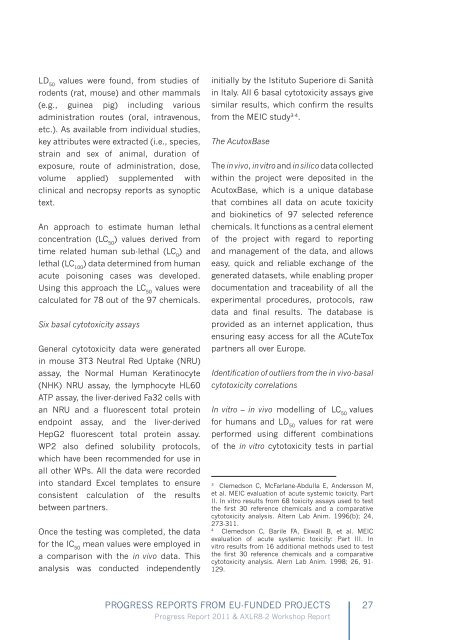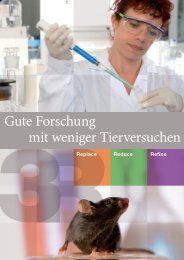You also want an ePaper? Increase the reach of your titles
YUMPU automatically turns print PDFs into web optimized ePapers that Google loves.
LD 50<br />
values were found, from studies of<br />
rodents (rat, mouse) and other mammals<br />
(e.g., guinea pig) including various<br />
administration routes (oral, intravenous,<br />
etc.). As available from individual studies,<br />
key attributes were extracted (i.e., species,<br />
strain and sex of animal, duration of<br />
exposure, route of administration, dose,<br />
volume applied) supplemented with<br />
clinical and necropsy reports as synoptic<br />
text.<br />
An approach to estimate human lethal<br />
concentration (LC 50<br />
) values derived from<br />
time related human sub-lethal (LC 0<br />
) and<br />
lethal (LC 100<br />
) data determined from human<br />
acute poisoning cases was developed.<br />
Using this approach the LC 50<br />
values were<br />
calculated for 78 out of the 97 chemicals.<br />
Six basal cytotoxicity assays<br />
General cytotoxicity data were generated<br />
in mouse 3T3 Neutral Red Uptake (NRU)<br />
assay, the Normal Human Keratinocyte<br />
(NHK) NRU assay, the lymphocyte HL60<br />
ATP assay, the liver-derived Fa32 cells with<br />
an NRU and a fluorescent total protein<br />
endpoint assay, and the liver-derived<br />
HepG2 fluorescent total protein assay.<br />
WP2 also defined solubility protocols,<br />
which have been recommended for use in<br />
all other WPs. All the data were recorded<br />
into standard Excel templates to ensure<br />
consistent calculation of the results<br />
between partners.<br />
Once the testing was completed, the data<br />
for the IC 50<br />
mean values were employed in<br />
a comparison with the in vivo data. This<br />
analysis was conducted independently<br />
initially by the Istituto Superiore di Sanità<br />
in Italy. All 6 basal cytotoxicity assays give<br />
similar results, which confirm the results<br />
from the MEIC study 3-4 .<br />
The AcutoxBase<br />
The in vivo, in vitro and in silico data collected<br />
within the project were deposited in the<br />
AcutoxBase, which is a unique database<br />
that combines all data on acute toxicity<br />
and biokinetics of 97 selected reference<br />
chemicals. It functions as a central element<br />
of the project with regard to reporting<br />
and management of the data, and allows<br />
easy, quick and reliable exchange of the<br />
generated datasets, while enabling proper<br />
documentation and traceability of all the<br />
experimental procedures, protocols, raw<br />
data and final results. The database is<br />
provided as an internet application, thus<br />
ensuring easy access for all the ACuteTox<br />
partners all over Europe.<br />
Identification of outliers from the in vivo-basal<br />
cytotoxicity correlations<br />
In vitro – in vivo modelling of LC 50<br />
values<br />
for humans and LD 50<br />
values for rat were<br />
performed using different combinations<br />
of the in vitro cytotoxicity tests in partial<br />
3<br />
Clemedson C, McFarlane-Abdulla E, Andersson M,<br />
et al. MEIC evaluation of acute systemic toxicity. Part<br />
II. In vitro results from 68 toxicity assays used to test<br />
the first 30 reference chemicals and a comparative<br />
cytotoxicity analysis. Altern Lab Anim. 1996(b); 24,<br />
273-311.<br />
4<br />
Clemedson C, Barile FA, Ekwall B, et al. MEIC<br />
evaluation of acute systemic toxicity: Part III. In<br />
vitro results from 16 additional methods used to test<br />
the first 30 reference chemicals and a comparative<br />
cytotoxicity analysis. Alern Lab Anim. 1998; 26, 91-<br />
129.<br />
PROGRESS REPORTS FROM EU-FUNDED PROJECTS<br />
Progress Report 2011 & AXLR8-2 Workshop Report<br />
27




